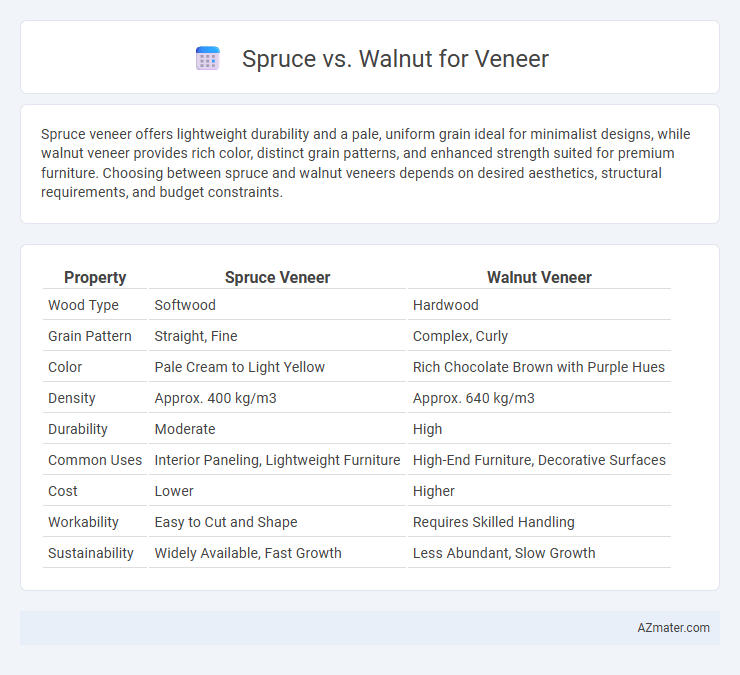Spruce veneer offers lightweight durability and a pale, uniform grain ideal for minimalist designs, while walnut veneer provides rich color, distinct grain patterns, and enhanced strength suited for premium furniture. Choosing between spruce and walnut veneers depends on desired aesthetics, structural requirements, and budget constraints.
Table of Comparison
| Property | Spruce Veneer | Walnut Veneer |
|---|---|---|
| Wood Type | Softwood | Hardwood |
| Grain Pattern | Straight, Fine | Complex, Curly |
| Color | Pale Cream to Light Yellow | Rich Chocolate Brown with Purple Hues |
| Density | Approx. 400 kg/m3 | Approx. 640 kg/m3 |
| Durability | Moderate | High |
| Common Uses | Interior Paneling, Lightweight Furniture | High-End Furniture, Decorative Surfaces |
| Cost | Lower | Higher |
| Workability | Easy to Cut and Shape | Requires Skilled Handling |
| Sustainability | Widely Available, Fast Growth | Less Abundant, Slow Growth |
Introduction to Veneer Wood Choices
Spruce and walnut are popular veneer wood choices often selected for their unique aesthetic and structural qualities. Spruce veneer offers a light color with fine grain patterns ideal for creating a natural, bright appearance, while walnut veneer provides a rich, dark tone with complex grain textures that add warmth and sophistication. Selecting between spruce and walnut veneers depends on the desired finish, durability requirements, and overall design goals for furniture or interior paneling projects.
Overview of Spruce as a Veneer Material
Spruce veneer offers a lightweight, pale-toned surface with straight grain patterns, making it ideal for applications requiring a clean, minimalist look. Its excellent strength-to-weight ratio and good acoustic properties make it popular in musical instruments and lightweight furniture. Spruce veneers are easy to cut and shape, providing versatility in both modern and traditional woodworking projects.
Overview of Walnut as a Veneer Material
Walnut veneer is highly prized in woodworking and furniture making for its rich, dark brown color with intricate grain patterns that add depth and elegance to designs. Its durability and smooth texture make it an ideal choice for high-end cabinetry, paneling, and decorative surfaces. Walnut's natural resistance to wear and its ability to take finishes well ensure that veneer applications maintain a sophisticated appearance over time.
Grain Patterns: Spruce vs. Walnut
Spruce veneer features a light, straight grain pattern with a fine, uniform texture that enhances a clean, minimalist aesthetic. Walnut veneer displays rich, dark tones with complex, swirling grain patterns, including straight grains intermixed with curls and burls for a more dramatic, natural look. Choosing between spruce and walnut veneers depends on whether the desired style favors subtle simplicity or striking visual character in wood grain.
Color and Aesthetic Appeal
Spruce veneer showcases a pale, creamy yellow tone with subtle grain patterns that create a light and airy aesthetic, ideal for modern and Scandinavian interiors. Walnut veneer features rich chocolate brown hues with striking grain contrasts, offering a warm and sophisticated appeal suited for classic or luxurious designs. Both veneers provide distinct visual textures, with spruce emphasizing brightness and simplicity, while walnut delivers depth and elegance in wood finishes.
Durability and Longevity Comparison
Spruce veneer offers moderate durability with a lightweight structure, making it suitable for applications requiring flexibility but less resistance to wear. Walnut veneer exhibits superior durability and longevity due to its dense grain and natural resistance to dents and scratches, ideal for high-traffic or frequently used surfaces. Choosing walnut veneer ensures enhanced lifespan and sustained aesthetic appeal compared to the softer, less durable spruce veneer.
Workability and Ease of Application
Spruce veneer offers excellent workability due to its lightweight and soft texture, making it easy to cut, shape, and sand for intricate woodworking projects. Walnut veneer, while slightly harder, provides a smooth surface that readily accepts adhesives and finishes, ensuring strong bonds and a polished appearance. Both veneers perform well in application, but spruce's softer grain enhances ease of manipulation, whereas walnut's durability benefits projects requiring a more robust finish.
Cost and Availability
Spruce veneer is generally more affordable and widely available due to the fast-growing nature of spruce trees, making it a cost-effective choice for large-scale projects. Walnut veneer tends to be more expensive and less abundant, reflecting the tree's slower growth and high demand for its rich, dark grain. Cost-conscious buyers often prefer spruce for budget-friendly applications, while walnut is chosen for premium finishes despite its higher price and limited availability.
Environmental Impact and Sustainability
Spruce veneer is typically sourced from fast-growing, sustainably managed forests, making it a renewable option with a lower carbon footprint compared to walnut. Walnut veneer, while prized for its rich color and durability, often comes from slower-growing trees and may involve more intensive harvesting practices that impact biodiversity. Choosing spruce supports reforestation and reduces environmental strain, whereas walnut requires careful sourcing to ensure sustainability and minimize ecological disruption.
Choosing the Right Veneer: Spruce or Walnut?
Spruce veneer offers a light, uniform appearance ideal for modern and minimalist interiors, while walnut veneer provides rich, warm tones with intricate grain patterns suited for classic and luxurious designs. Choosing between spruce and walnut veneer depends on the desired aesthetic, durability requirements, and budget considerations, as walnut typically commands a higher price due to its dense grain and natural resilience. Spruce's softness makes it easier to work with and more cost-effective for large surface applications, whereas walnut's hardness enhances longevity in high-traffic areas or furniture with frequent use.

Infographic: Spruce vs Walnut for Veneer
 azmater.com
azmater.com